 |
|
John F Kennedy Intl Airport |
 |
 |
| John F. Kennedy International Airport |
 |
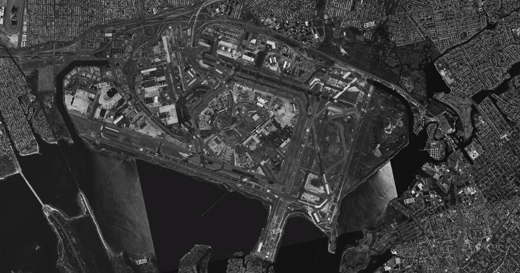 |
| USGS aerial image as of April 8, 1994 |
| IATA: JFK – ICAO: KJFK – FAA LID: JFK
Location of airport in New York state
|
| Summary |
| Airport type |
Public |
| Owner |
City of New York |
| Operator |
Port Authority of New York and New Jersey |
| Location |
Southern Queens, NY |
| Hub for |
- American Airlines
- Delta Air Lines
- Evergreen International Airlines
- JetBlue Airways
- Polar Air Cargo
|
| Elevation AMSL |
13 ft / 4 m |
| Coordinates |
40°38′23″N 073°46′44″W / 40.63972°N 73.77889°W / 40.63972; -73.77889Coordinates: 40°38′23″N 073°46′44″W / 40.63972°N 73.77889°W / 40.63972; -73.77889 |
| Website |
|
| Runways |
| Direction |
Length |
Surface |
| ft |
m |
| 4L/22R |
11,351 |
3,460 |
Asphalt |
| 4R/22L |
8,400 |
2,560 |
Asphalt |
| 13L/31R |
10,000 |
3,048 |
Asphalt |
| 13R/31L |
14,511 |
4,423 |
Concrete |
| Helipads |
| Number |
Length |
Surface |
| ft |
m |
| H1 |
60 |
18 |
Asphalt |
| H2 |
60 |
18 |
Asphalt |
| H3 |
60 |
18 |
Asphalt |
| H4 |
60 |
18 |
Asphalt |
| Statistics (2009) |
| Aircraft operations (ACI) |
416,945 |
| Passengers (ACI) |
45,915,069 |
Source: Federal Aviation Administration
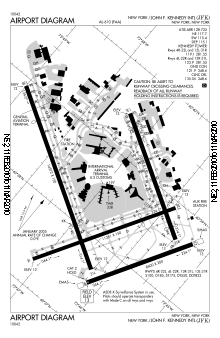
FAA airport diagram as of 20 November 2008
|
Map showing New York City and the locations of JFK (1), LaGuardia (2) and Newark (3) airports John F. Kennedy International Airport (IATA: JFK, ICAO: KJFK, FAA LID: JFK) is an international airport located in Queens County, on Long Island, in southeastern New York City. The airport is approximately 12 miles (19 km) from Lower Manhattan. It is the busiest international air passenger gateway to the United States. It is also the leading freight gateway to the country by value of shipments. In 2009, the airport handled 45,915,069 passengers, making it the 12th busiest airport in the world by this measure.
Over ninety airlines operate out of JFK. JFK International Airport is the base of operations for JetBlue Airways and is a major international gateway hub for American Airlines and Delta Air Lines. In the past, it has been a former hub for Eastern Air Lines, National Airlines, Pan American World Airways and Trans World Airlines. The airport was renamed after John F. Kennedy, the 35th President of the United States.
The airport is operated by the Port Authority of New York and New Jersey, which also manages the two other major airports in the New York metropolitan area, Newark Liberty and LaGuardia Airport. History
Construction
JFK Airport was originally known as Idlewild Airport (IATA: IDL, ICAO: KIDL, FAA LID: IDL) after the Idlewild Golf Course that it displaced. The airport was originally envisioned as a reliever for LaGuardia Airport, which had insufficient capacity in the late 1930s. Construction began in 1943; approximately $60 million was initially spent, but only 1,000 acres (400 ha) of land on the site of the Idlewild golf course were earmarked for use.
The project was renamed Major General Alexander E. Anderson Airport in 1943 after a Queens resident who had commanded a Federalized National Guard unit in the southern United States and who had died in late 1942. In March 1948, the New York City Council again changed the name of the airport to New York International Airport, Anderson Field, but the name "Idlewild" remained in common use until 1963.
The Port Authority leased the airport property from the City of New York in 1947 and maintains this lease as of the late 2000s. The first commercial flight at the airport was on July 1, 1948; the opening ceremony was attended by President Harry Truman. Upon opening Idlewild, the Port Authority cancelled foreign airlines' permits to use LaGuardia, effectively forcing them to move to the new airport.
The airport opened with six runways and a seventh under construction; runways 1L and 7L were held in reserve and (as it turned out) never did come into use as runways. Runway 31R (originally 8000 ft) is still in use; runway 31L (originally 9500 ft) opened soon after the rest of the airport and is still in use; runway 1R closed in the 1950s and runway 7R closed around 1966. Runway 4 (originally 8000 ft, now runway 4L) opened June 1949 and runway 4R was added ten years later.
The airport was renamed John F. Kennedy International Airport on December 24, 1963, one month after the assassination of President John F. Kennedy.
Development
The Port Authority originally envisioned a single 55-gate terminal for the airport, but the major airlines of the time did not agree with this plan, arguing that the terminal would be far too small for future traffic. Architect Wallace Harrison then designed a master plan under which each major airline at the airport would be given its own space to develop its own terminal design. This scheme made construction more practical, made terminals more navigable and introduced incentives for airlines to compete with each other for the best design. The revised master plan met airline approval in 1955.
- The International Arrivals Building was the first new terminal project at the airport. It was designed by Skidmore, Owings & Merrill and featured "finger" piers constructed at right-angles to the main building. These allowed a greater number of aircraft to park, a major design innovation at the time.
- United Airlines opened Terminal 9, a Skidmore design similar to that of the IAB, in October 1959. Eastern Airlines opened its Chester L. Churchill-designed Terminal 1 one month later.
- American Airlines opened its Terminal 8 in 1960. The terminal was designed by Kahn and Jacobs and became known for its 317 feet (97 m) stained glass facade designed by Robert Sowers, which was the largest stained glass installation in the world until 1979. The facade was removed in 2007 as the terminal was demolished to make room for the new Terminal 8; American cited the prohibitive cost of removing the enormous installation.
- Pan American World Airways opened the Worldport (now Terminal 3) in 1960. It featured a large, elliptical roof suspended by 32 sets of radial posts and cables; the roof extended 114 feet (35 m) beyond the base of the terminal to cover the passenger loading area. It was one of the first airline terminals in the world to feature Jetways that connected to the terminal and that could be moved to provide an easy walkway for passengers from the terminal to a docked aircraft, rather than having to board the plane outside via airstairs, which descend from an aircraft, via truck-mounted mobile stairs, or via wheeled stairs.
- Trans World Airlines opened the TWA Flight Center in 1962, designed by Eero Saarinen with a distinctive winged-bird shape. With the demise of TWA in 2001, the terminal remained vacant until 2005 when JetBlue Airways and the Port Authority of New York and New Jersey (PANYNJ) financed the construction of a new 26-gate terminal partly encircling the Saarinen building. Called now Terminal 5 (or simply T5), the new terminal opened October 22, 2008. T5 will be connected to the Saarinen central building through the original passenger departure-arrival tubes which connected the building to the outlying gates; the Port Authority is working on renovations of the remaining original Saarinen terminal, also known as the head house.
- Northwest Airlines, Braniff International and Northeast Airlines opened a joint terminal in 1962.
- National Airlines opened the Sundrome (now Terminal 6) in 1970. The terminal was designed by I.M.Pei. It was unique for its use of all-glass mullions dividing the window sections, unprecedented at the time. In 2001, United Airlines planned to redevelop this terminal and the TWA Flight Center as a new United terminal, but the airline later reduced its operation at JFK and abandoned plans for a future JFK hub. Terminal 6 was used by JetBlue Airways from 2001 through 2008 and vacated when JetBlue moved to Terminal 5.
JFK was designed to accommodate aircraft up to 300,000 lb gross weight and had to be significantly modified in the late 1960s to accommodate Boeing 747s.
Airlines began scheduling jets into Idlewild in 1958-59; LaGuardia didn't get jet airliners until 1964, so Idlewild soon became New York's busiest airline airport. During 1960-66 LaGuardia got a new terminal and longer runways, and by the middle 1970s the two airports had roughly equal passenger airline traffic (by flight count, not passenger count). (Until the 1980s Newark was always third place, except during LGA's reconstruction.) The supersonic Concorde, operated by Air France and British Airways, provided scheduled trans-Atlantic supersonic service to JFK from November 22, 1977 until October 24, 2003, when Concorde was retired by both carriers. JFK had the most Concorde operations annually of any airport in the world.
JFK is currently undergoing a $10.3 billion redevelopment. The airport began construction of the AirTrain JFK rapid transit system in 1998; completed in December 2003, the rail network links each airport terminal to New York City subways and regional commuter trains at Howard Beach and Jamaica, Queens. The airport opened a new Terminal 1 on May 28, 1998, and the $1.4 billion replacement for the International Arrivals Building, Terminal 4, opened on May 24, 2001. Construction has been completed on JetBlue Airways's new Terminal 5, which incorporates the historic landmark TWA FlightCenter terminal, while Terminals 8 and 9 were recently demolished and rebuilt as a unified Terminal 8 for the American Airlines hub. In 2008 the Port Authority Board of Commissioners approved a $20 million planning study for the much needed redevelopment of Terminals 2 and 3, the hub of Delta Air Lines.
On March 19, 2007, JFK became the first airport in the United States to receive the Airbus A380 with passengers aboard. The route-proving flight with more than 500 passengers was operated jointly by Lufthansa and Airbus and arrived at Terminal 1. On August 1, 2008, JFK received the first regularly-scheduled commercial A380 flight to the United States, operated by Emirates on its New York–Dubai route using Terminal 4. This service was suspended in 2009, due to poor passenger demand. With passenger numbers up for Emirates on North America air traffic in the year 2009-10, they will reintroduce the A380 from October 31, 2010.
Terminals, airlines and destinations
JFK has eight passenger terminals containing 151 gates. The terminal buildings are arranged in a deformed U-shaped wavy pattern around a central area containing parking, hotels, a power plant, and other airport facilities. The terminals are connected by the AirTrain system and access roads. Wayfinding signage throughout the terminals was designed by Paul Mijksenaar. A 2006 survey by J.D. Power and Associates in conjunction with Aviation Week found JFK ranked second in overall traveller satisfaction among large airports in the United States, behind McCarran International Airport which serves the Las Vegas metropolitan area.
Terminals
The airport has eight terminals (nine until the early 2000s), seven of which are currently in use, with Terminal 3 scheduled for demolition in 2013.
- Terminal 1
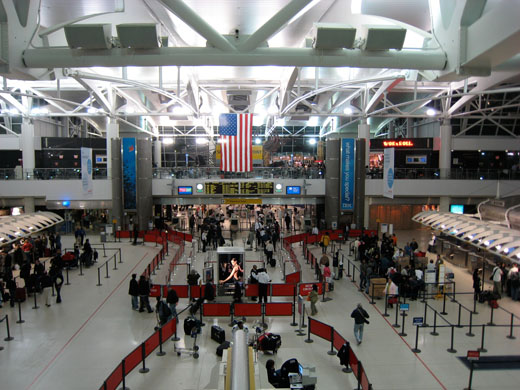 | |
Terminal 1 |
The original Terminal 1, built as a hub for Eastern Airlines, was demolished.
The current Terminal 1 was opened in 1998, 50 years after the opening of JFK, at the direction of the Terminal One Group, a consortium of four key operating carriers: Air France, Japan Airlines, Korean Air and Lufthansa. This partnership was founded after the four airlines reached agreement that existing international carrier facilities were inadequate for their needs. Terminal One has the capability to handle the Air France A380 route from Paris Charles De Gaulle. Terminal 1 has 11 gates.
- Terminal 2
Terminal 2 was opened in 1962 as the home of Northeast Airlines, Braniff and Northwest Airlines. After the demise of Northeast Airlines and Braniff the building was taken over by Delta Air Lines. It has 7 jetway-equipped gates (20–22, 26–29) and 17 stands for Delta Connection carriers (23A-H, 23J, 25K-N, 25P-S). Delta plans to connect T2 with T4 once it moves int'l operations into T4 and demolishes T3. The project was approved by the Port Authority on August 5, 2010.
- Terminal 3
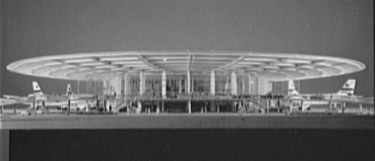 | |
The original configuration of the Pan Am Worldport at JFK airport, now simply known as Terminal 3. |
Terminal 3 was built as the Worldport in 1960 for Pan American, and substantially expanded for the introduction of the 747 in 1970. Delta Air Lines currently uses the entire terminal, and has a connector to Terminal 2, its other terminal at JFK. Terminal 3 has 16 jetway equipped gates: 1–10, 12, 14–18 with two hardstand gates (Gate 11) and a helipad on Taxiway 'KK'.
In August, 2010, a 1.2 billion dollar project was announced which would expand T4 into which Delta would move its current T3 operations, demolish T3 immediately following Terminal 4's expansion in 2013 to provide additional aircraft parking stands to speed up ground handling, and construct a connector between T2 and T4 for Delta transfers. T3 would be entirely demolished in 2015, including the 'flying saucer' roof, after the T4 expansion is completed.
- Terminal 4
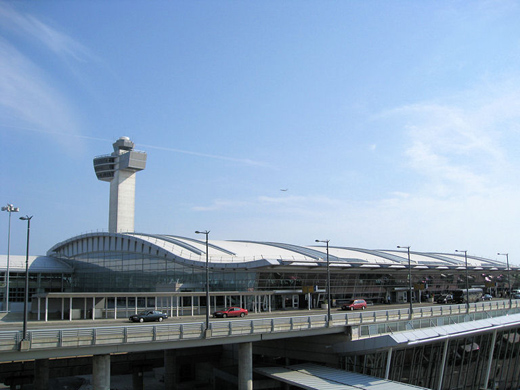 | |
Terminal 4 replaced the former International Arrivals Building in May 2001 |
Terminal 4, the international terminal, is able to handle the Airbus A380 and was developed by LCOR, Inc and is managed by the Schiphol Group. It was the first airport terminal in the United States to be managed by a foreign airport operator. Terminal 4 is the major gateway for international arrivals at JFK. Opened in 2001, the new 1,500,000-square-foot (139,000 m) building was built at a cost of $1.4 billion and replaced JFK's old International Arrivals Building, or simply IAB, which opened in 1957. Terminal 4 has 17 gates in two concourses: A2-A7, B20, B22-B31. The number of gates will be expanded for all of Delta Air Lines international flights to be operated from Terminal 4 in the future. A photo was released which shows additional expansion of T4 to include "regional jet" gates, although this phase has not yet been officially confirmed.
Concourse A has six gates, numbered A2-A7. Concourse B has eleven gates, numbered B20-B31, with the exclusion of B21. As Terminal 4 was built during the construction of the AirTrain, the AirTrain station was built inside the terminal building. Other AirTrain stations are built across from terminal buildings. Terminal 4’s expansive shopping mall offers a wide range of retail options before security so passengers and their families can enjoy shopping and dining together. Four chapels are located on the fourth floor (departure level). Delta Air Lines has also commenced operations from T4, as it expands operations beyond T2 and T3, and will eventually move all of its international services from T3. Passengers may check in at T2 (First and Business Class), T3 or T4 for all Delta flights.
- Terminal 5
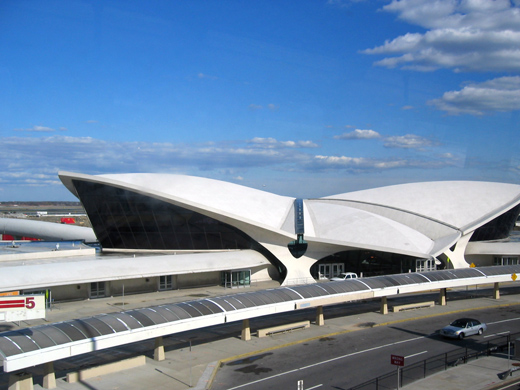 | |
The Saarinen building |
Terminal 5 is the new home of JetBlue Airways. The recently-completed terminal is known for its many gift shops and gourmet restaurants, including a steak house and a sushi restaurant. It sits behind the preserved Eero Saarinen-designed terminal originally known as the TWA Flight Center, which is now connected to the new structure and is considered part of T5. The Saarinen building is currently closed for refurbishment; it is unclear when the building will re-open or what purpose it will have. The active T5 building has 26 gates: 1–12, 14–27.
- Terminal 6
Terminal 6, which had 14 gates, is now closed. Designed by I. M. Pei, it was built in 1970 as the National Airlines Sundrome. Later, United Airlines used it for transcontinental flights. On June 1, 2006, JetBlue began service from Terminal 6, opening a temporary complex that increased its capacity by adding seven gates. After JetBlue vacated the terminal, these were demolished. The original building is also to be demolished, to make way for future Terminal 5 expansion.
- Terminal 7
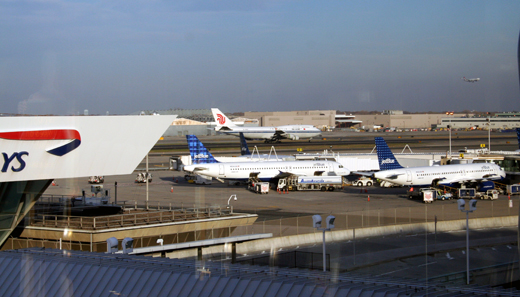 | |
Terminals 6 and 7 |
Terminal 7 was built for BOAC and Air Canada in the early 1970s. It is currently owned and operated by British Airways. A variety of Oneworld alliance carriers operate out of Terminal 7, including British Airways, Cathay Pacific, Iberia (now merged with British Airways) and Qantas. Star Alliance carriers United Airlines, US Airways and ANA also use the terminal. In 1997, the Port Authority entered an agreement with British Airways to expand the terminal. The renovated terminal has 12 gates. On May 21, 2008, British Airways announced that it would undertake a $30 million, 18-month-long project to enhance its premium ground facilities at the terminal. British Airways is currently evaluating the future of Terminal 7, as its lease with the Port Authority ends in 2015.
Management has indicated a desire to relocate British Airways/Iberia's operations to a new pier located east and connected to Terminal 8, pending approval of an alliance with American Airlines.
- Terminal 8
In 1999, American Airlines began an eight-year program to build the largest passenger terminal at JFK, designed to replace both Terminal 8 and Terminal 9. The new terminal was built in four phases, which involved the construction of a new midfield concourse, demolition of the old Terminal 9, and finally demolition of the old Terminal 8. It opened in stages between 2005 and its "official" opening in August 2007. It is a major Oneworld hub, and American Airlines is the major Oneworld carrier at Terminal 8. In addition to operations at Terminal 7, some Oneworld airlines including Finnair operate out of Terminal 8.
The terminal is about 50% larger than Madison Square Garden. It offers dozens of retail and food outlets, 84 ticket counters, 44 self-service kiosks, 10 security checkpoint lanes and a U.S. Customs and Border Protection facility that can process more than 1,600 people an hour. Terminal 8 has an annual capacity of 12.8 passengers. It has two American Airlines Admirals Clubs and a Flagship Lounge for premium class passengers.
Terminal 8 has 29 gates: 12 gates in Concourse B (1–8, 10, 12, 14, and 16) and 17 gates in Concourse C (31–47). Gate 31 is further subdivided into 5 regional service gates for small jets, 31A-31E. Gate 32 is subdivided into 4 regional service gates for small jets, 32F-32I. The total number of jetbridges is, therefore, 36. Concourse C is unusual in that to reach the concourse, passengers must descend on an escalator (or elevator) and walk through a short tunnel, then ascend another escalator to the concourse. Of interest are a history of American Airlines logos on display between the security checkpoint and the concourses.
Airlines and destinations
| Airlines |
Destinations |
Terminal |
| Aer Lingus |
Dublin, Shannon [seasonal] |
4 |
| Aeroflot |
Moscow-Sheremetyevo |
1 |
| Aerogal |
Guayaquil, Quito |
4 |
| Aeroméxico |
Mexico City, Puerto Vallarta |
1 |
| Aerosvit Airlines |
Kiev-Boryspil |
4 |
| Air Berlin |
Berlin-Tegel [begins May 1], Düsseldorf [seasonal] |
8 |
| Air China |
Beijing-Capital |
1 |
| Air Europa |
Madrid |
4 |
| Air France |
Paris-Charles de Gaulle |
1 |
| Air India |
Delhi, Mumbai |
4 |
| AIRES |
Bogota |
4 |
| Alitalia |
Milan-Malpensa, Rome-Fiumicino |
1 |
| All Nippon Airways |
Tokyo-Narita |
7 |
| American Airlines |
Aruba, Austin, Barbados, Barcelona, Bermuda, Brussels, Buenos Aires-Ezeiza, Cancún, Caracas, Chicago-O'Hare, Dallas/Fort Worth, Fort Lauderdale [begins November 18], Havana [charter], Las Vegas, London-Heathrow, Los Angeles, Madrid, Miami, Milan-Malpensa, Montego Bay, Orlando, Paris-Charles de Gaulle, Port-au-Prince, Providenciales, Punta Cana, Rio de Janeiro-Galeão [begins November 18], St Kitts, St Lucia, St Maarten, St. Thomas, San Diego, San Francisco, San José de Costa Rica, San Juan, Santiago de los Caballeros, Santo Domingo, São Paulo-Guarulhos, Seattle/Tacoma, Tampa, Tokyo-Haneda [begins January 20], Tokyo-Narita, Zürich
Seasonal: Eagle/Vail, Manchester (UK), Rome-Fiumicino |
8 |
| American Eagle |
Baltimore, Boston, Cincinnati/Northern Kentucky [begins November 18], Cleveland, Columbus (OH), Halifax, Indianapolis [begins November 18], Montréal-Trudeau, Norfolk [begins November 18], Pittsburgh, Raleigh/Durham, St. Louis, Toronto-Pearson, Washington-Reagan |
8 |
| Arik Air |
Lagos |
4 |
| Asiana Airlines |
Seoul-Incheon |
4 |
| Austrian Airlines |
Vienna |
1 |
| Avianca |
Bogotá, Cali, Medellin-Cordova |
4 |
| British Airways |
London-City, London-Heathrow |
7 |
| Caribbean Airlines |
Georgetown, Port of Spain |
4 |
| Caribbean Airlines operated by Air Jamaica |
Grenada, Kingston, Montego Bay |
4 |
| Cathay Pacific |
Hong Kong, Vancouver |
7 |
| Cayman Airways |
Georgetown, Grand Cayman |
1 |
| China Airlines |
Taipei-Taoyuan |
1 |
| China Eastern Airlines |
Shanghai-Pudong |
1 |
| Copa Airlines |
Panama City |
4 |
| Delta Air Lines |
London-Heathrow, Los Angeles, San Francisco |
2 |
| Delta Air Lines |
Abuja, Accra, Amman-Queen Alia, Amsterdam, Antigua, Aruba, Athens, Atlanta, Berlin-Tegel, Bogotá, Brussels, Budapest, Cairo, Cincinnati/Northern Kentucky, Copenhagen, Dakar, Denver, Detroit, Dublin, Fort Lauderdale, Frankfurt, Georgetown, Istanbul-Atatürk, Las Vegas, Manchester (UK), Mexico City, Miami, Milan-Malpensa, Minneapolis/St. Paul, Moscow-Sheremetyevo, Mumbai [resumes October 30], Nice, Orange County, Orlando, Phoenix, Port-au-Prince, Portland (OR), Prague, Punta Cana, Reykjavik-Keflavík [begins June 1], Rome-Fiumicino, Salt Lake City, San Antonio, San Diego, Santiago de los Caballeros, Santo Domingo, São Paulo-Guarulhos, Seattle/Tacoma, Shannon, Stockholm-Arlanda, Tampa, Tel Aviv, Tokyo-Narita, Venice-Marco Polo
Seasonal: Bonaire, Budapest, Grand Cayman, Grenada, Kiev-Boryspil, Pisa, St. Thomas, Zürich |
3 |
| Delta Air Lines |
Barcelona, Madrid, San Juan
Seasonal: Málaga, Montego Bay, Valencia |
4 |
| Delta Connection operated by Chautauqua Airlines |
Charlotte, Columbus (OH), Hartford, Norfolk, Philadelphia, Pittsburgh |
3 |
| Delta Connection operated by Comair |
Albany (NY), Baltimore, Bangor, Boston, Buffalo, Burlington (VT), Charlotte, Chicago-O'Hare, Cincinnati/Northern Kentucky, Cleveland, Columbus (OH), Dallas/Fort Worth, Detroit, Houston-Intercontinental, Kansas City, Memphis, Minneapolis/St. Paul, Montréal-Trudeau, Nashville, Norfolk, Philadelphia, Pittsburgh, Portland (ME), Raleigh/Durham, Richmond, Rochester (NY), St. Louis, Syracuse, Toronto-Pearson, Washington-Dulles, Washington-Reagan
Seasonal: Charlottetown, Nantucket |
3 |
| Delta Connection operated by Mesaba Airlines |
Buffalo, Chicago-O'Hare, Cincinnati/Northern Kentucky, Detroit, Minneapolis/St. Paul |
3 |
| Delta Connection operated by Pinnacle Airlines |
Albany (NY), Baltimore, Chicago-O'Hare, Cleveland, Hartford, Indianapolis, Montréal-Trudeau, Nashville, Rochester (NY), Toronto-Pearson, Washington-Dulles |
3 |
| Delta Connection operated by Shuttle America |
Detroit |
3 |
| EgyptAir |
Cairo |
4 |
| El Al |
Tel Aviv |
4 |
| Emirates |
Dubai |
4 |
| Etihad Airways |
Abu Dhabi |
4 |
| Finnair |
Helsinki |
8 |
| Iberia |
Madrid |
7 |
| Icelandair |
Reykjavik-Keflavík |
7 |
| Japan Airlines |
Tokyo-Narita |
1 |
| Jet Airways |
Brussels, Chennai |
8 |
| JetBlue Airways |
Aguadilla, Aruba, Austin, Barbados, Bermuda, Boston, Buffalo, Burbank, Burlington, Cancún, Charlotte, Chicago-O'Hare, Denver, Fort Lauderdale, Fort Myers, Houston-Hobby, Jacksonville (FL), Kingston, Las Vegas, Long Beach, Los Angeles, Montego Bay, Nassau, New Orleans, Oakland, Orlando, Phoenix, Pittsburgh, Ponce, Portland (ME), Portland (OR), Providenciales [begins February 17], Puerto Plata, Punta Canna, Raleigh/Durham, Richmond [ends November 1st], Rochester, Sacramento, St Lucia, St Maarten, Salt Lake City, San Diego, San Francisco, San Jose (CA), San Juan, Santiago de los Caballeros, Santo Domingo, Sarasota/Bradenton, Seattle/Tacoma, Syracuse, Tampa, Washington-Dulles, West Palm Beach
Seasonal: Nantucket |
5 |
| KLM Royal Dutch Airlines |
Amsterdam |
4 |
| Korean Air |
Seoul-Incheon |
1 |
| Kuwait Airways |
Kuwait, London-Heathrow |
4 |
| LAN Airlines |
Lima, Santiago de Chile, Toronto-Pearson |
4 |
| LAN Ecuador |
Guayaquil |
4 |
| LOT Polish Airlines |
Rzeszów [seasonal], Warsaw |
4 |
| Lufthansa |
Frankfurt, Munich |
1 |
| Meridiana Fly |
Naples, Palermo [All Seasonal] |
4 |
| Pakistan International Airlines |
Karachi, Lahore |
4 |
| Qantas |
Sydney |
7 |
| Qatar Airways |
Doha |
4 |
| Royal Air Maroc |
Casablanca |
1 |
| Royal Jordanian |
Amman-Queen Alia |
4 |
| Saudi Arabian Airlines |
Jeddah, Riyadh |
1 |
| Singapore Airlines |
Frankfurt, Singapore |
4 |
| South African Airways |
Dakar, Johannesburg |
4 |
| Sun Country Airlines |
Minneapolis/St. Paul |
4 |
| Swiss International Air Lines |
Geneva, Zürich |
4 |
| TACA Airlines |
San Pedro Sula, San Salvador |
4 |
| TACA Airlines operated by Lacsa |
San José de Costa Rica |
4 |
| TAM Airlines |
Rio de Janeiro-Galeão, São Paulo-Guarulhos |
4 |
| Transaero |
Moscow-Domodedovo [begins October 29] |
4 |
| Turkish Airlines |
Istanbul-Atatürk |
1 |
| United Airlines |
Los Angeles, San Francisco |
7 |
| United Express operated by Atlantic Southeast Airlines |
Washington-Dulles |
7 |
| United Express operated by Shuttle America |
Washington-Dulles |
7 |
| US Airways |
Charlotte, Phoenix |
7 |
| Uzbekistan Airways |
Riga, Tashkent |
4 |
| Virgin America |
Las Vegas, Los Angeles, San Francisco |
4 |
| Virgin Atlantic Airways |
London-Heathrow |
4 |
| Vision Airlines |
Havana [scheduled charter] |
8 |
| XL Airways France |
Paris-Charles de Gaulle [seasonal] |
1 |
Cities outside the US and Canada served by direct flights from JFKInfrastructure and services
Runways and operational infrastructure
Four runways (two pairs of parallel runways) surround the airport's central terminal area.
| Number |
Length |
Width |
ILS |
Notes |
| 13R-31L |
14,572 feet (4,442 m) |
200 feet (61 m) |
Cat. I (31L) |
Second-longest commercial runway in North America (the longest is a 16,000 feet (4,900 m) runway at Denver International Airport). Adjacent to Terminals 1, 2 and 3. Handled approximately one half of the airport's scheduled departures. It was the backup runway for space shuttle missions. It was closed on March 1, 2010 for four months. The reconstruction of the runway widened it from 150 feet (46 m) to 200 feet (61 m) with a concrete base instead of asphalt. It reopened on June 29, 2010. |
| 4R-22L |
8,400 feet (2,600 m) |
200 feet (61 m) |
Cat. III (both directions) |
Equipped at both ends with Approach Lighting Systems (ALS) with sequenced flashers, and touchdown zone (TDZ) lighting. The first Engineered Materials Arresting System (EMAS) in North America was installed at the northeast end of the runway in 1996. The bed consists of cellular cement material, which can safely decelerate and stop an aircraft that overruns the runway. The arrestor bed concept was originated and developed by the Port Authority and installed at JFK Airport as a joint research and development project with the FAA and industry. |
| 4L-22R |
11,351 feet (3,460 m) |
150 feet (46 m) |
Cat. I (both directions) |
Adjacent to Terminals 4 and 5. Both ends allow instrument landings down to three-quarters of a mile visibility. Takeoffs can be conducted with one-eighth of a mile visibility. |
| 13L-31R |
10,000 feet (3,000 m) |
150 feet (46 m) |
Cat. II (13L); Cat. I (31R) |
Equipped at both ends with ILS and ALS systems. Runway 13L has two additional visual aids for landing aircraft, a Visual Approach Slope Indicator System (VASI) and a Lead-In Lighting System (LDIN). The ILS on 13L, along with TDZ lighting, allows landings down to half a mile visibility. Takeoffs can be made with visibility of one-eighth of a mile. |
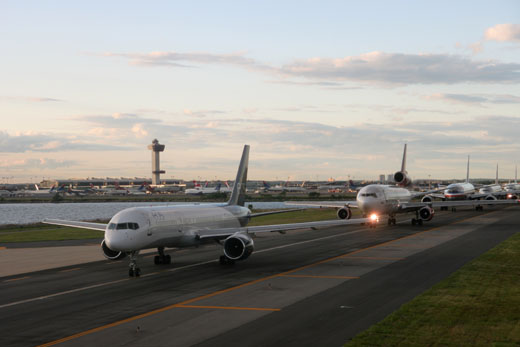 | |
Plane queue on the taxiway |
JFK has over 25 miles (40 km) of taxiways to move aircraft in and around the airfield. The standard width of these taxiways is 75 feet (23 m), with 25-foot (7.6 m) heavy-duty shoulders and 25-foot (7.6 m) erosion control pavements on each side. The taxiways have centerline lights and are generally of asphalt concrete composition 15 to 18 inches (460 mm) thick. An illuminated sign system provides directional information for taxiing aircraft.
The Air Traffic Control Tower, designed by Pei Cobb Freed & Partners and constructed on the ramp-side of Terminal 4, began full FAA operations in October 1994. An Airport Surface Detection Equipment (ASDE) radar unit sits atop the tower. A gas-fired electric cogeneration plant generates electricity for the airport, with an output of about 90 megawatts. It uses thermal energy from the capture of waste heat to heat and cool all of the passenger terminals and other facilities in the central terminal area.
Aircraft service facilities include seven aircraft hangars, an engine overhaul building, a 32-million gallon aircraft fuel storage facility, and a truck garage.
Information servicesIn the immediate vicinity of the airport, parking and other information can be obtained by tuning to a highway advisory radio station at 1630 AM. A second station at 1700 AM provides information on traffic concerns for drivers leaving the airport.
Kennedy Airport, along with LaGuardia and Newark airports, uses a uniform style of signage throughout the airport properties. Yellow signs direct passengers to airline gates, ticketing and other flight services; green signs direct passengers to ground transportation services, and black signs lead to restrooms, telephones and other passenger amenities.
New York City traffic reporter Bernie Wagenblast provides the voice for the airport's radio stations and the messages heard onboard AirTrain JFK and in its stations.
Traffic and statistics
In 2009, JFK handled 45,915,069 passengers.
The airport contributes about $30.1 billion in economic activity to the New York City region, generating 229,000 jobs and about $9.8 billion in wages and salaries. About 35,000 people are employed at the airport.
By passengers carried, the five largest airlines at JFK are:
- JetBlue Airways (25.5%)
- Delta Air Lines (including the Delta Connection carriers) (21.9%)
- American Airlines (including American Eagle) (16.7%)
- British Airways (2.8%)
- Air France (1.9%)
Nearly 100 airlines from over 50 countries operate regularly scheduled flights from JFK. The JFK-London Heathrow route is the leading U.S. international airport pair with over 2.9 million passengers in 2008. Domestic travel also accounts for a large share of airport traffic, particularly transcontinental and Florida service. Air freight
JFK is the nation’s busiest international air freight gateway by value of shipments and the second busiest overall by value including all air, land and sea U.S. freight gateways. Over 21% of all U.S. international air freight by value and 11% by tonnage moved through JFK in 2003.
The JFK air cargo complex is a Foreign Trade Zone which legally lies outside the customs area of the United States. JFK is a major hub for air cargo between the United States and Europe. London, Brussels and Frankfurt are JFK's three top trade routes. The European airports are mostly a link in a global supply chain, however. The top destination markets for cargo flying out of JFK in 2003 were Tokyo, Seoul and London. Similarly, the top origin markets for imports at JFK were Seoul, Hong Kong, and Taipei, with London taking the fourth spot.
Nearly 100 cargo air carriers operate out of JFK, among them: Air China Cargo, ABX Air, Asiana, Astar Air Cargo, Atlas Air, CAL Cargo Air Lines, Cargolux, Cargoitalia, Cathay Pacific Cargo, China Airlines, DHL, EVA Air, Emirates SkyCargo, Evergreen International Airlines, Nippon Cargo Airlines, FedEx Express, DHL Air UK, Kalitta Air, Korean Air, Lufthansa Cargo, Prince Edward Air, TNT Airways, United Cargo, UPS, Southern Air. Top 5 carriers together transported 33.1% of all “revenue” freight in 2005: American Airlines (10.9% of the total), FedEx Express (8.8%), Lufthansa Cargo (5.2%), Korean Air Cargo (4.9%), China Airlines (3.8%).
Most cargo and maintenance facilities at JFK are located north and west of the main terminal area. DHL, FedEx Express, Japan Airlines, Lufthansa, Nippon Cargo Airlines and United Airlines have cargo facilities at JFK. In 2000, Korean Air Cargo opened a new $102 million cargo terminal at JFK with total floor area of 81,124 square feet (7,536.7 m) and capability of handling 200,000 tons annually. In 2007, American Airlines opened a new priority parcel service facility at their Terminal 8, featuring 30-minute drop-offs and pick-ups for priority parcel shipments within the US.
Scheduled cargo airlines and destinations
| Airlines |
Destinations |
| ABX Air |
Cincinnati/Northern Kentucky, Halifax, Liège |
| Air China Cargo |
Beijing-Capital, Shanghai-Pudong |
| Asiana Airlines Cargo |
Brussels, Seoul-Incheon |
| Astar Air Cargo |
Cincinnati/Northern Kentucky |
| CAL Cargo Air Lines |
Liège, Tel Aviv |
| Cargoitalia |
Milan-Malpensa |
| Cargolux |
Luxembourg, Mexico City |
| Cathay Pacific Cargo |
Hong Kong |
| DHL Aviation |
East Midlands, Leipzig/Halle |
| El Al Cargo |
Liège, Tel Aviv |
| Evergreen International Airlines |
Hahn, Hong Kong, Shanghai-Pudong |
| FedEx Express |
Indianapolis, Memphis |
| Kalitta Air |
Bahrain, Leipzig/Halle, Liège |
| Korean Air Cargo |
Seoul-Incheon |
| Lufthansa Cargo |
Frankfurt |
| Nippon Cargo Airlines |
Tokyo-Narita |
| Saudia Cargo |
Brussels, Riyadh |
| TNT Airways |
Liège, Reykjavik-Keflavik |
| UPS Airlines |
Chicago-Rockford, Louisville, Philadelphia |
Ground transportationRail
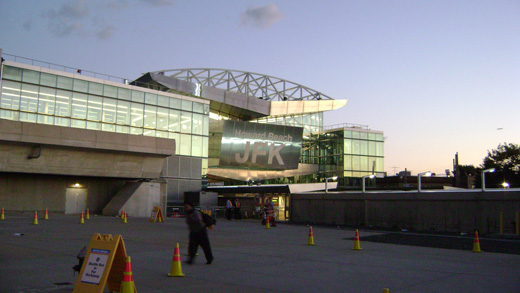 | |
The Howard Beach-JFK Airport subway station in Howard Beach |
JFK is connected to New York's subway and commuter rail system by AirTrain JFK. AirTrain stops at all terminals, parking lots, hotel shuttle areas, car rental lots, 2 subway stations & the Long Island Rail Road. It is free within the airport. Travel time between JFK and Midtown Manhattan is approximately 30–40 minutes (depending on the originating/terminating terminal at JFK) using AirTrain and the Long Island Rail Road at Jamaica Station; or approximately 75 minutes between JFK and Downtown Manhattan using AirTrain and the New York City Subway A train at Howard Beach-JFK Station or the E (to Midtown Manhattan), J and Z (to Downtown Manhattan) trains at Sutphin Boulevard Station.
A Lower Manhattan-Jamaica/JFK Transportation Project has been proposed to connect the AirTrain to Lower Manhattan.
Bus
Several city bus lines link JFK to the New York City Subway and Long Island Rail Road, including the Q3, Q6, Q7, Q10 (Local/Limited), and B15, with free transfers provided for subway connections. The buses are handicapped accessible. There are also many private bus lines operating express buses to Manhattan, the Hudson Valley, and Long Island.
Taxi
New York City's yellow cabs, licensed by the New York City Taxi & Limousine Commission, offer a flat rate service of $45 from JFK airport to Manhattan, excluding tips and tolls. Since November 30, 2006, this flat rate fare (excluding tips and tolls) applies to travel from Manhattan to JFK as well. Depending on the time of day, taxi travel from JFK to Midtown Manhattan can be as quick as 35 minutes. Door-to-door Car Service is another popular transportation option.
Car
JFK Airport is easily accessible by car and is located in southern Queens on the Van Wyck Expressway (I-678), which can be accessed from the Belt Parkway, the Grand Central Parkway and Queens Boulevard. A ring road connects the airport terminals to the Belt Parkway and the Van Wyck Expressway. The airport offers customers over 17,000 parking spaces, included in multi-level parking garages, surface spaces in the Central Terminal Area, a long-term parking lot and valet parking. Many people looking for long term parking at JFK on major travel days have a hard time finding spaces or finding spaces that are close to the monorail. Consequently they have to drag their luggage through vast parking lots until they can get to the shuttle stops or the monorail. A number of off-site airport parking facilities have come in existence to help alleviate the problem of getting from a parked car to a departure terminal. These companies offer 24/7 service to and from the terminals. JFK Long Term Parking offers free on demand Valet service.
Van Wyck Expressway twists through the terminal nucleus and turns into the JFK Expressway. This four-lane expressway allows for more convenient access to the airport for Long Island users via the westbound Belt Parkway. Because it lies almost entirely within Kennedy Airport, the JFK Expressway was constructed, and is maintained by the Port Authority. The JFK Expressway was built as part of an ongoing, multi-billion overhaul of Kennedy Airport that began in the late 1980s. It was designed to relieve up to 30 percent of the traffic volume from the Van Wyck Expressway. Approximately 6 major rental car companies serve JFK Airport, with rental locations located on and off the airport. Each terminal's arrivals level (usually near the baggage carousel) has either a rental car counter or courtesy telephone for each of the car rental companies.
Helicopter
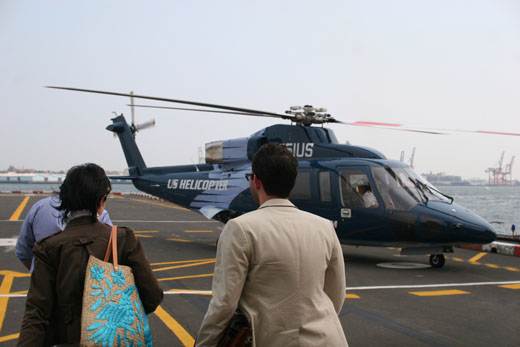 | |
US Helicopter departing from the Downtown Manhattan Heliport |
US Helicopter operated regularly scheduled flights every hour between Terminal 3 and the East 34th Street Heliport. Passengers traveling by helicopter to the airport passed through a security checkpoint at the heliport, not at JFK. On May 14, 2007, US Helicopter moved its operations from Terminal 9 to Terminal 3. US Helicopter announced that it was temporarily suspending operations on September 25, 2009 due to financial difficulties.
New York Airways provided helicopter service from JFK to other area airports and heliports from 1955 to 1979, and Pan American World Airways continued Manhattan helicopter service during the 1980s in order to feed its JFK flights. During the 1970s, New York Helicopter offered JFK flights from the top of the Pan Am Building in midtown Manhattan, but this service was cancelled after a major accident in 1977.
Accidents and incidentsJFK has been the site of several notable aviation accidents and incidents.
- On 19 October 1953, an Eastern Airlines flight from Idlewild International Airport to San Juan, Puerto Rico, operated by Lockheed L-749A Constellation N119A crashed on take-off. Two passengers were killed.
- December 18, 1954 – a Linee Aeree Italiane Douglas DC-6 crashed on its fourth approach attempt to land at Idlewild (the former name of JFK), after circling for 2.5 hours. 26 of the 32 passengers on board were killed.
- November 10, 1958 – Vickers Viscount, CF-TGL of Trans-Canada Air Lines was destroyed by fire after it was struck by Lockheed L-749 Super Constellation N6503C of Seaboard & Western Airlines which had crashed on take-off.
- December 16, 1960 – a United Airlines Douglas DC-8 collided with a TWA Super Constellation on approach to the airport; the United jet crashed in a Brooklyn neighborhood, the TWA plane on Staten Island, killing 127 people on board and five on the ground.
- March 1, 1962 – American Airlines Flight 1, a Boeing 707 crashed on takeoff from Idlewild after its rudder separated from the tail. All 95 passengers and 12 crew members were killed.
- November 30, 1962 – an Eastern Air Lines Douglas DC-7 crashed into the ground during a missed approach.
- February 8, 1965 – an Eastern Air Lines Douglas DC-7 crashed off Jones Beach after takeoff when the pilots found themselves on an apparent collision course with an inbound Pan Am Boeing 707 and made evasive maneuvers.
- 1967 – The Air France Robbery targeted $420,000 in cash brought in as Air France cargo.
- September 8, 1970 – a Trans International Airlines DC-8-63CF ferry flight to Dulles International Airport crashed on takeoff from runway 13R, killing all 11 crewmembers on board. The DC-8 freighter started rotating in a nose-high attitude 1,500 feet (460 m) into the take-off. After becoming airborne at 2,800 feet (850 m) down the runway, the aircraft climbed to about 300–500 feet, rolled 20 degrees to the left, crashed and caught fire. The loss of pitch control was caused by the entrapment of a pointed, asphalt-covered object between the leading edge of the right elevator and the right horizontal spar web access door in the aft part of the stabilizer.
- December 1, 1974 – Northwest Orient Flight 6231 a Boeing 727 chartered to pick up the Baltimore Colts in Buffalo crashed near Thiells, New York. The flight departed John F. Kennedy International Airport with only the cockpit crew onboard. The pitot heat was not turned on and the tube iced over during climb out making the airspeed readings unreliable. The plane stalled passing 23,000' and the crew was unable to regain control. All 3 crewmembers onboard were killed.
- June 24, 1975 – Eastern Air Lines Flight 66, a Boeing 727 on final approach from New Orleans, crashed into the runway lights short of runway 22L, killing 112 passengers and crew. The cause of the crash was wind shear during a heavy thunderstorm.
- December 11, 1978 – The Lufthansa heist targeted over $5 million in cash and jewels on a Lufthansa flight arriving from Germany; at the time, it was the largest cash robbery ever committed on American soil.
- January 25, 1990 – Avianca Flight 52, a Boeing 707-321B arriving from Bogotá and Medellin, crashed at Cove Neck, Long Island, after a missed approach to runway 22L at JFK and subsequently running out of fuel. 73 passengers and crew perished. 85 survived.
- July 30, 1992 – TWA Flight 843, a Lockheed L-1011 departing for San Francisco, aborted takeoff shortly after liftoff. There were no fatalities among the 280 passengers, although the aircraft was destroyed.
- November 12, 2001 – American Airlines Flight 587, an Airbus A300 crashed while en route to Santo Domingo in the Dominican Republic. During climb, the aircraft lost most of its vertical fin due to the co-pilot's overcontrol of the rudder while encountering wake turbulence, and crashed into the Belle Harbor neighborhood of Queens. The crash killed all 260 people on the plane and five people on the ground.
- On September 6, 2007, TAM Airlines Flight 8080 suffered a heavy landing due to the elevators not responding in the landing flare. An investigation revealed that #2 flight control primary computer did not match #1 and #3 computers, sending erroneous messages to the actuators for the elevators.
- January 16, 2010 – Terminal 8 was evacuated and passengers rescreened after a person bypassed security. According to a spokesman for the Port Authority of New York and New Jersey, which operates the airport, the evacuation was triggered when a man left an American Airlines first-class lounge through a restricted door.
- February 16–17, 2010 – Air Traffic Controller Glenn Duffy brought his seven year old son to work and allowed him to direct two airliners. The following day, he brought in his eight year old daughter and also allowed her to direct several airliners. These incidents prompted Duffy and his supervisor to be suspended from their jobs without pay, and an FAA investigation.
- August 9, 2010 - Jet Blue Flight 1052 Flight Attendant, Steven Slater turned very angry at a passenger, and told everyone on the plane that he was irritated, and he was going to quit his job. He opened the door of the plane, and the slide deployed. He took a couple cans of beer in his hand. He got in his jeep, and went to his house, where he was arrested at his house, for criminal mischief, and reckless endangerment. He reported, he was having a bad day. The next day, he was let out on a 1500 Dollar Bond, and if convicted, the former flight attendant could serve 7 years in prison.
- September 25, 2010 - Delta Air Lines Flight 4951 crashlanded after right-side landing gear failed to deploy.
Other accidents and incidents involving JFK include:
- Sabena Flight 548 (1961), outbound from JFK, crashed while trying to land in Brussels, Belgium
- Eastern Air Lines Flight 401 (1972), outbound from JFK, crashed while trying to land in Miami, Florida
- Pan Am Flight 1736 (1977), originated from LAX and stopped at JFK, collided with another 747 at Tenerife
- LOT Polish Airlines Flight 007 (1980), outbound from JFK, crashed while trying to land in Warsaw, Poland
- Korean Air Lines Flight 007 (1983), originated from JFK, shot down by Soviet jet interceptors off the coast of Sakhalin after it strayed into prohibited Soviet airspace because of a navigational error
- Pan Am Flight 103 (1988), bound for JFK, with continued service to Detroit, exploded over Lockerbie, Scotland
- TWA Flight 800 (1996), outbound from JFK, bound for Paris, exploded soon after takeoff, and crashed off the coast of Long Island
- Swissair Flight 111 (1998), outbound from JFK, bound for Geneva, crashed off the coast of Nova Scotia
- EgyptAir Flight 990 (1999), outbound from JFK, bound for Cairo, crashed off the coast of Nantucket
- Air France Flight 4590 (2000), a Concorde bound for JFK, crashed in Gonesse, France
- Korean Air Flight 85 (2001), bound for JFK on September 11, was escorted by fighter jets to Whitehorse International Airport during Operation Yellow Ribbon on fears it may have been hijacked. This was not the case; the plane was low on fuel, and according to a public affairs official at the airport, there was also a communication problem with the air crew. When the plane landed, witnesses reported that the Royal Canadian Mounted Police ordered the crew out at gunpoint. The entire incident was a misunderstanding caused by a malfunctioning transponder.
- JetBlue Airways Flight 292 (2005), was bound for JFK when the nose landing gear twisted 90 degrees to the right, perpendicular to the way the wheels normally face. The Airbus A320 had taken off from Bob Hope Airport in Burbank, California, and then made a successful emergency landing at Los Angeles International Airport. Of the 140 passengers and 5 crewmembers on board, no one was injured.
- On June 2, 2007, federal authorities announced that four people had been arrested in connection with an alleged terror plot to attack the JFK Airport. FBI officials say the men, one of whom was a former air cargo employee at the airport, planned to blow up terminal buildings and jet fuel infrastructure.
In popular cultureAs one of the major international gateways in the United States, JFK possesses a high profile in popular culture. The British Invasion began with the arrival of The Beatles at JFK in 1964, who held their first American press conference at the airport.
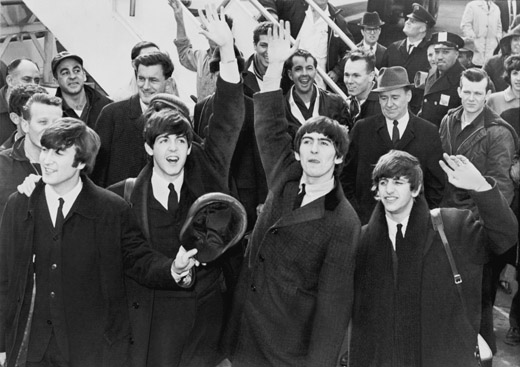 | |
The Beatles arrive at JFK Airport |
Rapper Notorious B.I.G. references the airport's code name in the song "Going Back to Cali." The theme song of the 1960s comedy TV series Car 54, Where Are You? contained a line reading: "There's a scout troop short a child, [Nikita] Khrushchev's due at Idlewild," referencing the airport's previous name, Idlewild. In his one-man show Red diaper baby, Josh Kornbluth's eccentric communist father insists on referring to JFK as the "Bay of Pigs Memorial Airport". JFK is also mentioned in the U2 song, "Angel of Harlem", as well as the song "The City" by Joe Purdy. In the Simpsons episode "$pringfield (Or, How I Learned to Stop Worrying and Love Legalized Gambling)" Mr. Burns builds the 'Spruce Moose' a parody of Howard Hughes's 'Spruce Goose' airplane, which he claims will fly from New York's Idlewild Airport to the Belgian Congo in seventeen minutes. A futuristic version of JFK was featured in The Fifth Element. In I Love Lucy, Lucy misses the USS Constitution bound for Europe and is forced to take a helicopter out of Idlewild Airport. Idlewild Airport was also mentioned in a Twilight Zone episode in which a plane en route to Idlewild travels through time. JFK is also used frequently by television series in the Law & Order franchise. British television series "The Saint" season 1, episode 4 ( 1962 ) begins its story with a shot of the terminal 3 building and a superimposed title " Idlewild International Airport". A long pan of the area, and then an announcement for Pan Am flight 114 to Paris
Many films have used JFK as a setting:
- Live and Let Die (1973) depicts James Bond arriving at JFK on a Pan Am 747.
- Dog Day Afternoon (1975)
- SST: Death Flight (1977) features JFK Airport for around the first 20 minutes of the film as its primary setting. In scenes many parts of the Airport can be seen including: various Terminals, runways, boarding areas, cargo loading bays and the full Airport can even be seen during a take-off sequence which shows a model of the fictitious Maiden One, a close-copy of the real American SST: the Boeing 2707 'taking-off' from the Airport. The film has also been re-titled as "Death Flight" and "SST Disaster In The Sky".
- Zombi 2 (1979)
- Moonstruck (1987)
- Three Men and a Baby (1987)
- Big Business (1988)
- Coming to America (1988)
- Bonfire of the Vanities (1989) shows a complicated shot of Concorde landing here, documented in the book The Devil's Candy.
- Goodfellas (1990) depicts the 1967 Air France Robbery and 1978 Lufthansa heist that are both unsolved major robberies conducted at the airport.
- Quick Change (1990)
- The Wedding Banquet (1993)
- Turbulence (1997)
- Final Destination (2000)
- Catch Me If You Can (2002) features scenes of JFK during the 1960s, including several scenes filmed in the original TWA Flight Center (old Terminal 5).
- Kangaroo Jack (2003) (cameo appearance)
- Anger Management (2003) (Featured Pakistan International Airlines 747 in background)
- The Terminal (2004) was set at JFK airport, but certain interior scenes were filmed on mock terminal movie sets, while other interior scenes and exterior scenes were filmed at Mirabel International Airport in Montreal.
- Taxi (2004)
- White Chicks (2004)
- Friends (2004) (series finale)
- School for Scoundrels (2006)
- Borat: Cultural Learnings of America for Make Benefit Glorious Nation of Kazakhstan (2006) depicts the title character arriving at JFK.
- Build It Bigger (2007)
- Bee Movie (2007) shows a plane carrying roses landing at Terminal 4.
- The Bourne Ultimatum (2007)
- The Visitor (2008)
- Brüno (2009) features the American Airlines baggage claim in Terminal 8.
- Conspiracy Theory with Jesse Ventura (2009) features Jesse Ventura unsuccessfully attempting to access Hangar 17, which contains steel beams and other WTC items from the 9/11/01 attacks. This was part of an investigation into whether or not 9/11 could have possibly been an American attack on American soil by covert means known as a "false flag" operation.
- Old Dogs (2009) The flight of Dan (John Travolta) and Charlie (Robin Williams) for Tokyo departs from JFK
The above content comes from Wikipedia and is published under free licenses – click here to read more.
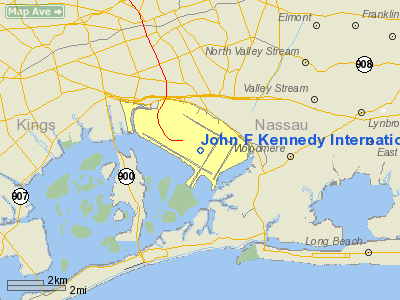
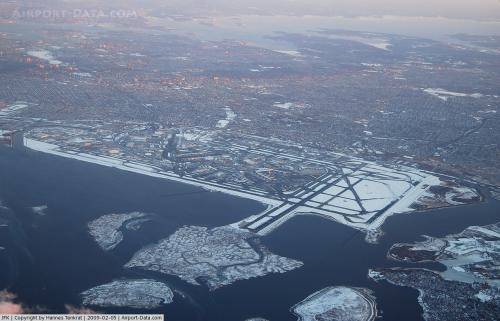 |
(Click on the photo to enlarge) |
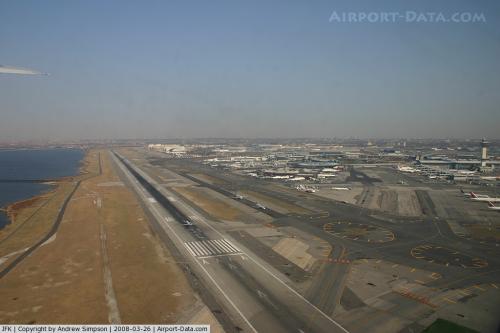 |
(Click on the photo to enlarge) |
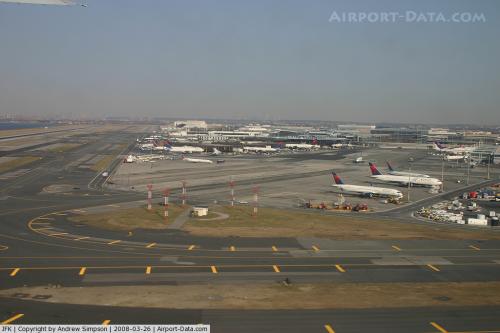 |
(Click on the photo to enlarge) |
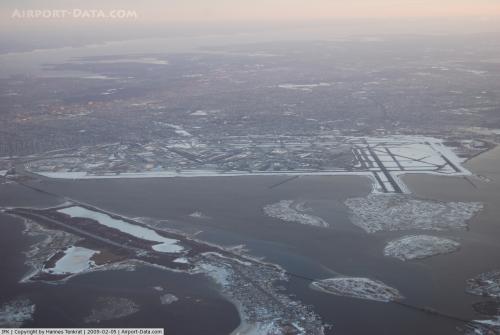 |
(Click on the photo to enlarge) |
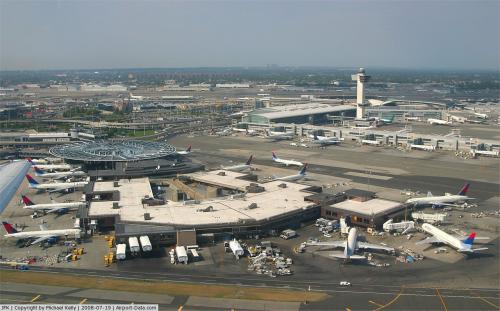 |
(Click on the photo to enlarge) |
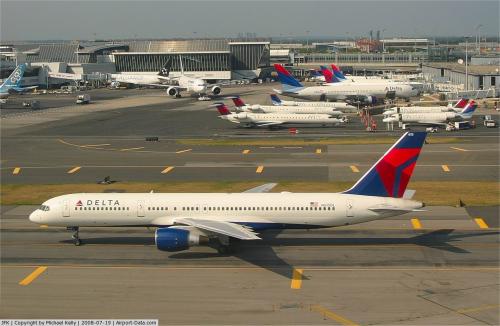 |
(Click on the photo to enlarge) |
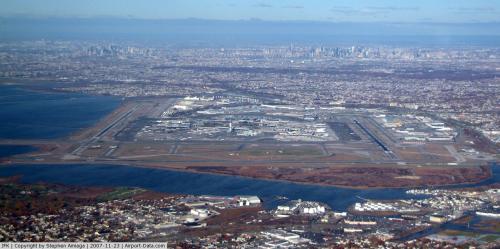 |
(Click on the photo to enlarge) |
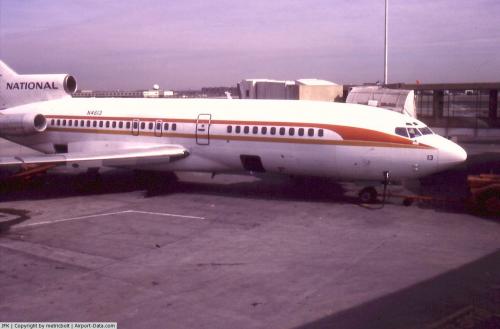 |
(Click on the photo to enlarge) |
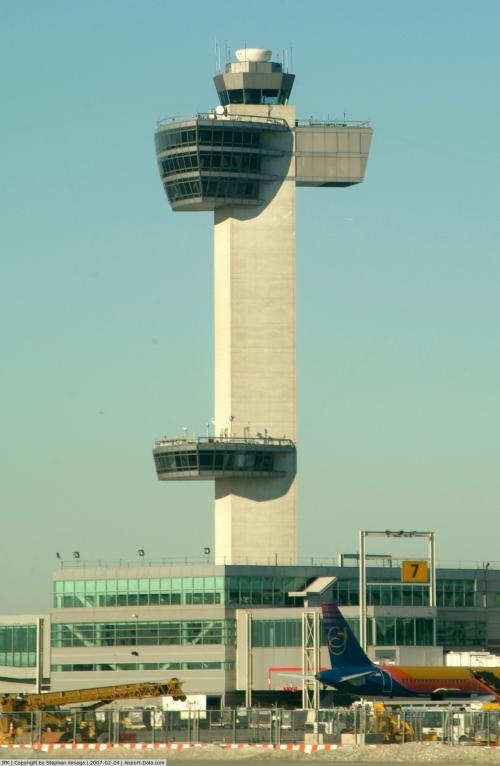 |
(Click on the photo to enlarge) |
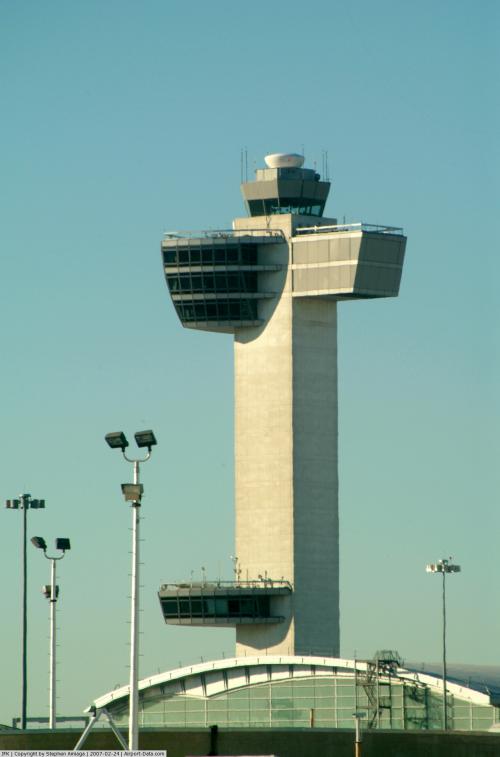 |
(Click on the photo to enlarge) |
Location & QuickFacts
| FAA Information Effective: | 2008-09-25 |
| Airport Identifier: | JFK |
| Airport Status: | Operational |
| Longitude/Latitude: | 073-46-44.1320W/40-38-23.1040N
-73.778926/40.639751 (Estimated) |
| Elevation: | 13 ft / 3.96 m (Surveyed) |
| Land: | 5200 acres |
| From nearest city: | 13 nautical miles SE of New York, NY |
| Location: | Queens County, NY |
| Magnetic Variation: | 14W (2000) |
Owner & Manager
| Ownership: | Publicly owned |
| Owner: | Port Authority Of New York & N.j.
LEASEE: PROPERTY OWNED BY CITY OF NEW YORK; BUREAU OF FERRY AND GENERAL AVIATION. |
| Address: | 225 Park Ave South 9th Floor
New York, NY 10003 |
| Phone number: | 212-435-3640 |
| Manager: | Susan M. Baer |
| Address: | Bldg 14
Jamaica, NY 11430 |
| Phone number: | 718-244-3501 |
Airport Operations and Facilities
| Airport Use: | Open to public |
| Wind indicator: | Yes |
| Segmented Circle: | No |
| Control Tower: | Yes |
| Lighting Schedule: | DUSK-DAWN |
| Beacon Color: | Clear-Green (lighted land airport) |
| Landing fee charge: | Yes |
| Sectional chart: | New York |
| Region: | AEA - Eastern |
| Boundary ARTCC: | ZNY - New York |
| Tie-in FSS: | ISP - New York |
| FSS on Airport: | No |
| FSS Toll Free: | 1-800-WX-BRIEF |
| NOTAMs Facility: | JFK (NOTAM-d service avaliable) |
| Certification type/date: | I E S 05/1973 |
| Federal Agreements: | NGSY3 |
Airport Communications
Airport Services
| Fuel available: | 100LLA
GENERAL AVIATION: NON-BASED CHARTER & NON-BASED COML ACFT OPERATORS MUST MAKE ARRANGEMENTS FOR FUEL PRIOR TO ARRIVAL; CALL 718-244-4111. |
| Airframe Repair: | MAJOR |
| Power Plant Repair: | MAJOR |
| Bottled Oxygen: | HIGH |
| Bulk Oxygen: | HIGH |
Runway Information
Runway 04L/22R
| Dimension: | 11351 x 150 ft / 3459.8 x 45.7 m |
| Surface: | ASPH-CONC, Good Condition |
| Surface Treatment: | Saw-cut or plastic Grooved |
| Weight Limit: | Dual wheel: 185000 lbs.
Dual tandem wheel: 550000 lbs.
Dual dual tandem wheel: 823000 lbs. |
| Edge Lights: | High |
| |
Runway 04L |
Runway 22R |
| Longitude: | 073-47-08.1070W | 073-45-52.8020W |
| Latitude: | 40-37-19.2640N | 40-38-55.6470N |
| Elevation: | 12.00 ft | 12.00 ft |
| Alignment: | 31 | 127 |
| ILS Type: | ILS/DME
| ILS/DME
|
| Traffic Pattern: | Left | Left |
| Markings: | Precision instrument, Good Condition | Precision instrument, Good Condition |
| Crossing Height: | 72.00 ft | 0.00 ft |
| Displaced threshold: | 0.00 ft | 2696.00 ft |
| VASI: | 4-light PAPI on left side | |
| Visual Glide Angle: | 3.00° | 0.00° |
| RVR Equipment: | touchdown, midfield, rollout | touchdown, midfield, rollout |
| Runway End Identifier: | Yes | |
| Centerline Lights: | Yes | Yes |
| Touchdown Lights: | No | No |
| Obstruction: | , 50:1 slope to clear | 10 ft fence, 280.0 ft from runway, 300 ft right of centerline, 8:1 slope to clear
APCH RATIO 50:1 TO DSPLCD THR. |
| Decleard distances: | Take off run available 11351.00 ft
Take off distance available 11351.00 ft
Actual stop distance available 11351.00 ft
Landing distance available 11351.00 ft
| Take off run available 11351.00 ft
Take off distance available 11351.00 ft
Actual stop distance available 11351.00 ft
Landing distance available 8655.00 ft
|
|
Runway 04R/22L
| Dimension: | 8400 x 200 ft / 2560.3 x 61.0 m |
| Surface: | ASPH, Good Condition |
| Surface Treatment: | Saw-cut or plastic Grooved |
| Weight Limit: | Dual wheel: 185000 lbs.
Dual tandem wheel: 550000 lbs.
Dual dual tandem wheel: 823000 lbs. |
| Edge Lights: | High |
| |
Runway 04R |
Runway 22L |
| Longitude: | 073-46-13.2500W | 073-45-17.5090W |
| Latitude: | 40-37-31.5320N | 40-38-42.8490N |
| Elevation: | 13.00 ft | 13.00 ft |
| Alignment: | 31 | 127 |
| ILS Type: | ILS/DME
| ILS/DME
|
| Traffic Pattern: | Left | Left |
| Markings: | Precision instrument, Good Condition | Precision instrument, Good Condition |
| Crossing Height: | 0.00 ft | 70.00 ft |
| VASI: | | 4-light PAPI on right side
RY 22L PAPI HORIZONTAL OFFSET 4 DEG TO LEFT. |
| Visual Glide Angle: | 0.00° | 3.00° |
| RVR Equipment: | touchdown, midfield, rollout | touchdown, midfield, rollout |
| Approach lights: | ALSF2 | ALSF2
NSTD LIGHT SPACING. |
| Centerline Lights: | Yes | Yes |
| Touchdown Lights: | Yes | Yes |
| Decleard distances: | Take off run available 8400.00 ft
Take off distance available 8400.00 ft
Actual stop distance available 8400.00 ft
Landing distance available 8400.00 ft
| Take off run available 8400.00 ft
Take off distance available 8400.00 ft
Actual stop distance available 8400.00 ft
Landing distance available 8400.00 ft
|
|
Runway 13L/31R
| Dimension: | 10000 x 150 ft / 3048.0 x 45.7 m |
| Surface: | ASPH, Good Condition |
| Surface Treatment: | Saw-cut or plastic Grooved |
| Weight Limit: | Dual wheel: 185000 lbs.
Dual tandem wheel: 550000 lbs.
Dual dual tandem wheel: 823000 lbs. |
| Edge Lights: | High |
| |
Runway 13L |
Runway 31R |
| Longitude: | 073-47-24.8623W | 073-45-33.3970W |
| Latitude: | 40-39-27.9533N | 40-38-37.4140N |
| Elevation: | 13.00 ft | 12.00 ft |
| Alignment: | 121 | 127 |
| ILS Type: | ILS/DME
| ILS/DME
|
| Traffic Pattern: | Right | Left |
| Markings: | Precision instrument, Good Condition | Precision instrument, Good Condition |
| Crossing Height: | 54.00 ft | 0.00 ft |
| Displaced threshold: | 905.00 ft | 1030.00 ft |
| VASI: | 12-box on both sides | |
| Visual Glide Angle: | 3.00° | 0.00° |
| RVR Equipment: | touchdown, midfield, rollout | touchdown, midfield, rollout |
| Approach lights: | ALSF2 | MALSR |
| Centerline Lights: | Yes | Yes |
| Touchdown Lights: | Yes | Yes |
| Obstruction: | 14 ft road, 650.0 ft from runway, 32:1 slope to clear
APCH RATIO 50:1 TO DSPLCD THR.
+14 FT LGTD FENCE 600 FT FM AER L TO R. | , 50:1 slope to clear
RY 31R +4 FT ELECTRIC EQUIPMENT BOX 70 FT FM RY END 150 FT R. |
| Decleard distances: | Take off run available 10000.00 ft
Take off distance available 10000.00 ft
Actual stop distance available 10000.00 ft
Landing distance available 9095.00 ft
| Take off run available 10000.00 ft
Take off distance available 10000.00 ft
Actual stop distance available 10000.00 ft
Landing distance available 8976.00 ft
|
|
Runway 13R/31L
| Dimension: | 14572 x 150 ft / 4441.5 x 45.7 m |
| Surface: | ASPH-CONC, Good Condition |
| Surface Treatment: | Saw-cut or plastic Grooved |
| Weight Limit: | Dual wheel: 185000 lbs.
Dual tandem wheel: 550000 lbs.
Dual dual tandem wheel: 823000 lbs. |
| Edge Lights: | High |
| |
Runway 13R |
Runway 31L |
| Longitude: | 073-49-00.1730W | 073-46-17.7390W |
| Latitude: | 40-38-54.1020N | 40-37-40.4790N |
| Elevation: | 12.00 ft | 12.00 ft |
| Alignment: | 121 | 127 |
| ILS Type: | | ILS
|
| Traffic Pattern: | Right | Left |
| Markings: | Precision instrument, Good Condition | Precision instrument, Good Condition |
| Crossing Height: | 43.00 ft | 0.00 ft |
| Displaced threshold: | 2606.00 ft | 3324.00 ft |
| VASI: | 12-box on both sides | |
| Visual Glide Angle: | 3.00° | 0.00° |
| RVR Equipment: | touchdown, midfield, rollout | touchdown, midfield, rollout |
| Approach lights: | LDIN | |
| Centerline Lights: | Yes | Yes |
| Touchdown Lights: | No | No |
| Decleard distances: | Take off run available 14572.00 ft
Take off distance available 14572.00 ft
Actual stop distance available 14572.00 ft
Landing distance available 11966.00 ft
| Take off run available 14572.00 ft
Take off distance available 14572.00 ft
Actual stop distance available 14572.00 ft
Landing distance available 11248.00 ft
|
|
Helipad H1
| Dimension: | 60 x 60 ft / 18.3 x 18.3 m |
| Surface: | ASPH, |
| |
Runway H1 |
Runway |
| Traffic Pattern: | Left | Left |
|
Helipad H2
| Dimension: | 60 x 60 ft / 18.3 x 18.3 m |
| Surface: | ASPH, Good Condition |
| |
Runway H2 |
Runway |
| Traffic Pattern: | Left | Left |
| Markings: | Basic, Good Condition | , |
|
Helipad H3
| Dimension: | 60 x 60 ft / 18.3 x 18.3 m |
| Surface: | ASPH, Good Condition |
| |
Runway H3 |
Runway |
| Traffic Pattern: | Left | Left |
| Markings: | Basic, Good Condition | , |
|
Helipad H4
| Dimension: | 60 x 60 ft / 18.3 x 18.3 m |
| Surface: | ASPH, Good Condition |
| |
Runway H4 |
Runway |
| Traffic Pattern: | Left | Left |
| Markings: | Basic, Good Condition | , |
|
Radio Navigation Aids
| ID |
Type |
Name |
Ch |
Freq |
Var |
Dist |
| EWR | FAN MARKER | Maryann | | | 11W | 19.0 nm |
| OGY | NDB | Bridge | | 414.00 | 12W | 6.4 nm |
| BBN | NDB | Babylon | | 275.00 | 14W | 18.1 nm |
| PNJ | NDB | Paterson | | 347.00 | 12W | 25.0 nm |
| CAT | NDB | Chatham | | 254.00 | 11W | 30.3 nm |
| OP | NDB | Old Field Point Light | | 316.00 | 13W | 36.2 nm |
| NEL | NDB | Lakehurst | | 396.00 | 13W | 43.9 nm |
| NEL | TACAN | Lakehurst | 055X | | 11W | 44.8 nm |
| NEL | UHF/NDB | Lakehurst | | 274.80 | 13W | 43.9 nm |
| JFK | VOR/DME | Kennedy | 106X | 115.90 | 12W | 0.5 nm |
| CRI | VOR/DME | Canarsie | 070X | 112.30 | 11W | 5.5 nm |
| LGA | VOR/DME | La Guardia | 078X | 113.10 | 12W | 10.0 nm |
| TEB | VOR/DME | Teterboro | 021X | 108.40 | 11W | 18.0 nm |
| DPK | VOR/DME | Deer Park | 124X | 117.70 | 12W | 23.5 nm |
| COL | VOR/DME | Colts Neck | 101X | 115.40 | 11W | 26.3 nm |
| CMK | VOR/DME | Carmel | 113X | 116.60 | 12W | 39.5 nm |
| BDR | VOR/DME | Bridgeport | 25X | 108.80 | 12W | 43.2 nm |
| SBJ | VOR/DME | Solberg | 076X | 112.90 | 10W | 44.1 nm |
| CCC | VOR/DME | Calverton | 119X | 117.20 | 13W | 47.9 nm |
| BWZ | VOR/DME | Broadway | 089X | 114.20 | 11W | 48.5 nm |
| RBV | VORTAC | Robbinsville | 085X | 113.80 | 10W | 42.0 nm |
| SAX | VORTAC | Sparta | 104X | 115.70 | 11W | 43.0 nm |
| JFK | VOT | Kennedy | | 115.10 | | 0.3 nm |
| ISP | VOT | Long Island Mac Arthur | | 109.40 | | 32.4 nm |
| BDR | VOT | Bridgeport | | 109.25 | | 43.2 nm |
Remarks
- GA TRAFFIC CONTACT ARPT OPS ON UNICOM FOR PARKING DIRECTIONS
- ENGINEERED MATERIALS ARRESTING SYSTEM (EMAS) 405 FT IN LENGTH BY 227 FT WIDTH LOCATED AT DEP END RY 22L.
- ASDE-X SURVEILLANCE SYSTEM IN USE: PILOTS SHOULD OPERATE TRANSPONDERS WITH MODE C ON ALL TWYS AND RWYS.
- FLOCKS OF BIRDS ON & INVOF ARPT.
- LDIN RY 13L USES 1000' LGT STN OF THE ALS ONLY WITH CRI VOR APCHS & IS ANGLED TOWARD AQUEDUCT; ALSO 5 SFL FM 1200-2000' & A 5 SFL GROUPING APROXLY 1 MI FM RY +1 ADJ FORMING APCH. APCH GATE ANGLED 35 DEGS S OF RY 13L CNTRLN DESIGNED TO PRVD EARLIER IDENT OF RY ENVI.
- FOR NOISE RESTRICTIONS CALL 212-435-3685 DURING NORMAL BUSINESS HOURS.
- ENGINEERED MATERIALS ARRESTING SYSTEM, 392 FT LONG BY 226 FT WIDE, LCTD AT DEP END RY 04R.
- ACFT PROHIBITED IN THE RUNUP BLOCK AREAS AT TWY Z. TO BE USED FOR TURN AROUND ONLY.
- PARA-SAIL & BANNER TOWING OPNS 1000 FT & BLO IN UPPER & LOWER NEW YORK BAYS INCLUDING ROCKAWAY INLET INDEFLY..
- SPECIAL AIR TFC RULES-PART 93 HIGH DENSITY ARPT. PROR RESERVATION REQUIRED. SEE AERONAUTICAL INFORMATION MANUAL.
Images and information placed above are from
http://www.airport-data.com/airport/JFK/
We thank them for the data!
| General Info
|
| Country |
United States
|
| State |
NEW YORK
|
| FAA ID |
JFK
|
| Latitude |
40-38-23.104N
|
| Longitude |
073-46-44.132W
|
| Elevation |
13 feet
|
| Near City |
NEW YORK
|
We don't guarantee the information is fresh and accurate. The data may
be wrong or outdated.
For more up-to-date information please refer to other sources.
|
 |



